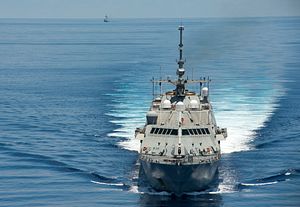In a letter to the secretary of the navy, Ray Mabus, and the U.S. Navy’s chief of naval operations, Admiral John Richardson, the senior leaders of the U.S. Senate Armed Services Committee—Senators John McCain and Jack Reed—question the warfighting capabilities of the Littoral Combat Ship (LCS) and the “Pentagon’s ability to develop and procure weapon systems in an effective, timely, and affordable manner.”
“We seldom hear from Navy leaders about these challenges and the path to achieving full operational capability. Instead, Navy leaders seem to be promoting the warfighting capabilities of the LCS,” the letter reads.
McCain and Reed take especially issue with remarks delivered by Ray Mabus at last month’s Surface Navy Association (SNA) symposium, where he said that:
[b]ecause [LCS] can deploy with a carrier strike group, because they have such robust anti-mine and anti-submarine capabilities we’re redesignating them as frigates… a group of small surface ships like LCS is still capable of putting the enemy fleet on the bottom of the ocean. Now that’s the success story.
However, the letter notes that this statement and other similar statements “do not appear to reflect the reality of the LCS program.” The senators go on to list a number of shortcomings and delays in the LCS program. Among other things, the letter questions the operational range of the LCS and whether it could be deployed along with a carrier strike groups.
The lawmakers are also pointing out delays in initial operational testing of LCS mine countermeasure (MCM) warfare, surface warfare (SuW), and anti-submarine warfare (ASW) mission packages.
As I reported previously, the U.S. Navy is still looking for a suitable over-the-horizon missile for the LCS as part of the SuW mission package. The U.S. Navy’s surface warfare director, Rear Admiral Peter Fanta, wants to put a new missile aboard the LCS by the end of 2016—at least as a demonstration. This will be critical for the re-organization of the surface fleet based on the so-called “distributed lethality” concept (see: “The US Navy’s New Surface Warfare Strategy: ‘Distributed Lethality”).
“While the Navy plans to put longer range anti-ship missiles on LCS, it has yet to do so and will likely only be able to accommodate a small number, which could be consumed by a single ship target,” McCain and Reed argue. “Unless the enemy fleet consists of a small number of lightly armed boats at extremely short range, we fail to see how the LCS reality is consistent with the Secretary’s remarks.”
The letter also notes that the U.S. Navy does not plan to test the ASW mission package in an “operational environment until 2017.” As a result, the Navy is still “years from an LCS anti-submarine warfare IOC[initial operating capability], which along with systems testing will also require the Navy to reduce the weight of these systems by up to 25 percent to fit on LCS and complete shipboard integration.”
In addition, McCain and Reed point out that the “timeline for achieving a proven mine countermeasures capability remains unclear.”
“Since 2009, the IOC for this package has been delayed by over four years. Meanwhile, legacy mine countermeasures platforms, including Avenger-class ships, Osprey-class ships, and Sea Dragon helicopters, have reached, are approaching, or have been extended beyond the end of their service lives,” their letter says.
In response to the letter, the U.S. Navy issued a statement to USNI News. “For this new ship class, we will continue to refine how we train, maintain, operate and deploy LCS based on what we have learn in operational tests, maintenance, and deployments,” said chief Navy spokesperson Rear Admiral Dawn Cutler.
“The first two deployments of LCS have been successful, but we still have work to do in order to better execute the mission for which this platform was designed. We look forward to working with the technical community, the fleet, and the Congress to address LCS concerns as we continue to spirally develop and strengthen this program,” she adds.
As I explained at the beginning of January, U.S. Defense Secretary Ashton Carter recently ordered the U.S. Navy to reduce the number of LCS to be built from 52 to 40. The 3,000-plus tons LCS has been a controversial naval acquisition due to cost inflation and numerous design and construction issues.

































